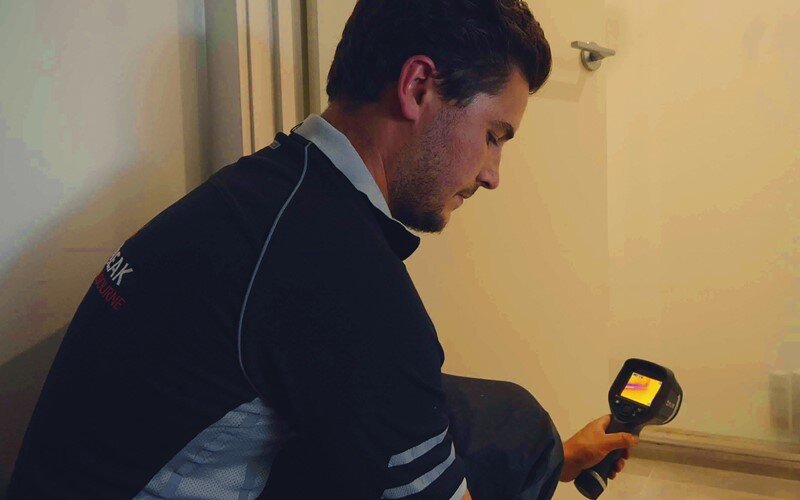6 Ways to Find Concealed Water Leakages in Your Home
6 Ways to Find Concealed Water Leakages in Your Home
Blog Article
The writer is making a number of great points on Finding hidden leaks overall in the content further down.

Early discovery of leaking water lines can minimize a prospective disaster. Some little water leaks might not be visible.
1. Check Out the Water Meter
Every home has a water meter. Examining it is a guaranteed manner in which helps you uncover leaks. For starters, switch off all the water sources. Make sure no one will purge, use the faucet, shower, run the cleaning machine or dishwashing machine. From there, most likely to the meter and also watch if it will change. Given that nobody is using it, there need to be no motions. If it moves, that indicates a fast-moving leak. If you find no adjustments, wait a hr or two and also check back once again. This indicates you might have a slow-moving leakage that could even be underground.
2. Inspect Water Usage
If you spot abrupt changes, in spite of your intake being the exact same, it suggests that you have leaks in your plumbing system. An unexpected spike in your costs indicates a fast-moving leak.
A steady increase every month, even with the same habits, reveals you have a slow-moving leakage that's likewise gradually intensifying. Call a plumber to thoroughly check your residential property, particularly if you feel a cozy location on your floor with piping underneath.
3. Do a Food Coloring Examination
30% comes from bathrooms when it comes to water consumption. Examination to see if they are running appropriately. Drop flecks of food color in the container as well as wait 10 mins. If the shade somehow infiltrates your dish throughout that time without flushing, there's a leakage between the storage tank and bowl.
4. Asses Outside Lines
Don't neglect to inspect your outdoor water lines too. Must water leak out of the link, you have a loosened rubber gasket. One tiny leakage can lose lots of water and surge your water bill.
5. Evaluate and Assess the Circumstance
Home owners ought to make it a behavior to check under the sink counters as well as also inside cabinets for any type of bad odor or mold and mildew development. These two red flags show a leakage so prompt interest is needed. Doing regular inspections, even bi-annually, can save you from a significant trouble.
Check for stainings and also damaging as a lot of devices and pipelines have a life expectancy. If you presume leaking water lines in your plumbing system, don't wait for it to rise.
Early detection of leaking water lines can minimize a potential catastrophe. Some little water leaks may not be visible. Inspecting it is a proven way that assists you find leakages. One little leakage can waste lots of water and also increase your water costs.
If you suspect dripping water lines in your plumbing system, don't wait for it to escalate.
WARNING SIGNS OF WATER LEAKAGE BEHIND THE WALL
PERSISTENT MUSTY ODORS
As water slowly drips from a leaky pipe inside the wall, flooring and sheetrock stay damp and develop an odor similar to wet cardboard. It generates a musty smell that can help you find hidden leaks.
MOLD IN UNUSUAL AREAS
Mold usually grows in wet areas like kitchens, baths and laundry rooms. If you spot the stuff on walls or baseboards in other rooms of the house, it’s a good indicator of undetected water leaks.
STAINS THAT GROW
When mold thrives around a leaky pipe, it sometimes takes hold on the inside surface of the affected wall. A growing stain on otherwise clean sheetrock is often your sign of a hidden plumbing problem.
PEELING OR BUBBLING WALLPAPER / PAINT
This clue is easy to miss in rooms that don’t get much use. When you see wallpaper separating along seams or paint bubbling or flaking off the wall, blame sheetrock that stays wet because of an undetected leak.
BUCKLED CEILINGS AND STAINED FLOORS
If ceilings or floors in bathrooms, kitchens or laundry areas develop structural problems, don’t rule out constant damp inside the walls. Wet sheetrock can affect adjacent framing, flooring and ceilings.
https://www.servicemasterbyzaba.com/blog/how-to-detect-water-leakage-in-walls/

We were shown that write-up on Locating water leaks from a friend on another domain. Feel free to take a moment to share this blog if you appreciated it. Thank you for taking the time to read it.
Report this page